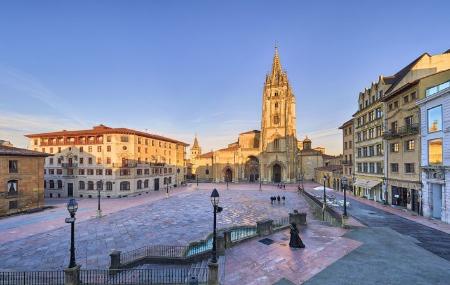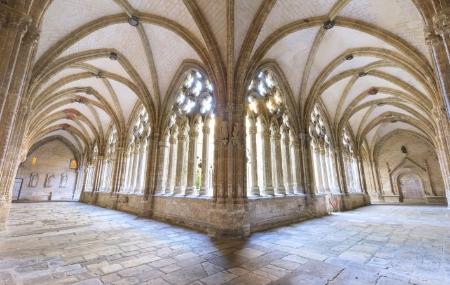
- Title Oviedo Asturias Centre
- Address Address: Pza. de Alfonso II, El Casto ■ 33003 - Oviedo/Uviéu
- Phone Phone: 985 219 642
- Email Email: catedral@catedraldeoviedo.com, grupos@catedraldeoviedo.com
- Site Site: https://catedraldeoviedo.com/
- Period Period: Gothic
- Documents Documents: Accessibility sheet
The Cathedral of El Salvador treasures twelve centuries of history, mainly due to the quantity and quality of the relics it preserves. Born of the spirit that animated the first Christian kingdom of the Iberian Peninsula, resistant and resilient in the face of the Muslim invasion, the Cathedral has always been and continues to be a strategic enclave. It has its origins in the basilica ordered to be built by King Alfonso II the Chaste, under the patronage of El Salvador. It was built on the ruins of an earlier church erected by his father Fruela I.
During the 14th century, the construction of the Gothic Cathedral began, demolishing the previous Romanesque and Pre-Romanesque basilica. This construction was completed in the middle of the 16th century with the completion of the tower, which means that the construction of the temple lasted almost three centuries. In addition, it was necessary to work for another hundred years on the construction of the chapels and pantheons that we see today attached to the side naves. Therefore, the entire construction process of the cathedral spans approximately four centuries, with the intense work during the 15th century, a period in which the florid or flamboyant Gothic style prevailed, to which our cathedral belongs, being particularly noteworthy.
The building is made up of three naves, the central one being the largest, and the side ones with chapels, preceded by a portico. During the Romanesque period, Alfonso III the Great considerably enriched the cathedral's treasury by donating the Victoria Cross, although he did not carry out any extensions to the basilica of El Salvador. With the transfer of the court to León in the 10th century, successive monarchs continued to enrich the basilica with their donations, which earned it great prestige during the Middle Ages and made it an essential destination for pilgrims and devotees. The apostolate of the Holy Chamber and the Old Tower belong to this period.
In the Gothic period, the Gothic Cloister replaced the previous Romanesque, with its corbels and capitals featuring a rich and varied iconography that includes both profane and religious themes, as well as medieval legends and specifically Asturian motifs, such as Favila's fight with the bear.On the south wall of the cloister is the Alms Door, with sculpted figures of Saint James, Saint Peter, Saint Paul and Saint Andrew on the jambs, the figure of El Salvador on the tympanum, and the Virgin of the Milk on the central pillar. Next to this door is the so-called Chapel of the Hydria, where, according to tradition, a hydria from the Wedding at Cana is kept, one of the miraculous remains most visited by pilgrims.
The portico is made up of three arches, of different sizes, which correspond to the naves of the church. The doors are later, although from the same century, and the reliefs of El Salvador and Santa Eulalia are carved on them. The Gothic Tower (which can be visited) is crowned by the spire with a height of sixty metres. The style of the High Altarpiece, located in the apse of the cathedral, oscillates between flamboyant Gothic and Renaissance. A monumental work of polychrome wood, it is divided into five sections. The main scenes are depicted in the central street: the Crucifixion, the Assumption and Coronation of the Virgin and The Saviour. It is considered one of the best Spanish Gothic altarpieces, along with those of Seville and Toledo.
In the Baroque period, the ambulatory or ambulatory was added around the middle of the 17th century. It is heptagonal in shape, with small chapels that offer us a group of Baroque altarpieces of marked Italian influence. The New Sacristy was added in 1733.
There are six chapels in the Cathedral, each with its own history and significance, which enrich the visitor's experience and reveal the diversity of styles and periods that make up this monument... Chapel of Santa Eulalia, Santa Eulalia was a girl from Emerita who lived her Christian faith during the persecutions of Emperor Diocletian at the beginning of the 4th century, receiving martyrdom for refusing to worship the Roman gods. The chapel as a whole was completed in 1702. The Chapel of Santa Bárbara, known at the time as "de San Miguel" or "Nueva Cámara Santa", was built between 1660 and 1663. Bishop Bernardo Caballero de Paredes is buried at the entrance of this chapel, so that all those who entered would step on his tomb, as he had left in writing in his will.
Chapel of the Vigiles, in 1615 the cathedral chapter gave the chapel located on the north side of the Cathedral to Juan Vigil de Quiñones, bishop of Valladolid and Segovia, from Gijón, so that he could build a funerary chapel for him and his family. The chapel was completed in 1640 after several lawsuits between the chapter and the bishop's family. The model for this funerary chapel was the Pantheon in Rome. The Chapel of Cristo de Velarde, so called because the Velarde family had owned it since the middle of the 17th century. This chapel had to give up part of its space to the Baroque staircase built to provide access to the Holy Chamber, and houses a magnificent sculpture of Christ crucified, known as Christ of Velarde, considered by many to be the best sculpture in the Cathedral.
Chapel of Covadonga or San Ildefonso, built between 1379 and 1382, it housed numerous tombs. It had three altars, but when the ambulatory was built in 1621, it had to be demolished, and a new chapel was built on the site it occupied, currently dedicated to the Virgin of Covadonga. The current altarpiece houses an image of the Santina, and at the Virgin's feet, in an ark, lie the remains of Saint Melchor de Quirós, the first Asturian saint martyred in Vietnam, so the chapel is also dedicated to him.
Chapel of Santa María del Rey Casto, which is accessed through a beautiful 15th-century Gothic doorway. It has three naves, the side naves being very narrow. In the transept, a large dome rests on pendentives decorated with effigies of Asturian monarchs. In this chapel there is a mixture of Gothic, classical and Baroque elements. The altarpiece in the chancel features the Assumption of the Virgin, and at the back of the chapel is the Pantheon of the Kings.
The Cathedral, together with the Monastery of San Salvador de Cornellana (Salas), both on the Primitive Way, the pre-Romanesque church of San Salvador de Priesca (Villaviciosa) and the church and rectory of Santa María de Soto de Luiña (Cudillero), both on the Coastal Way, have been recognised as Unesco World Heritage Sites.
The Cathedral of El Salvador is currently experiencing a golden age, with the strong momentum experienced in recent times by the Primitive Way, which maintains a constant flow of pilgrims and tourists throughout the year. In short, Oviedo Cathedral, which has been a source of inspiration for artists, writers and pilgrims, tells fascinating stories in every corner and in every stone. Stories of kings, bishops, relics and treasures, miracles, patriots, revolutionaries and even thieves. Stories that have been building and shaping the life of Western Europe over the last twelve centuries... And precisely because of its spiritual, historical, social and artistic importance, a guided tour of the Cathedral is a must.




